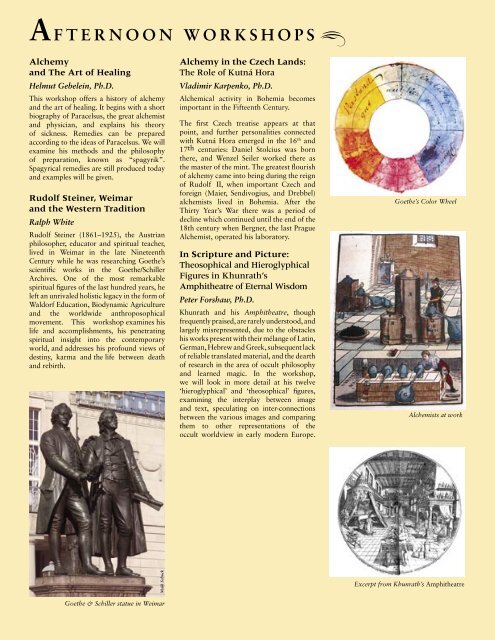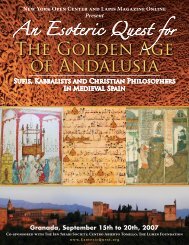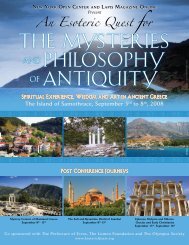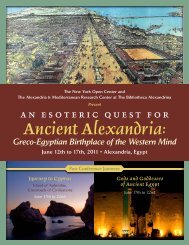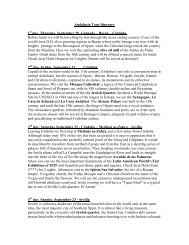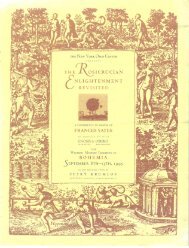An Esoteric Quest in Central Europe:
An Esoteric Quest in Central Europe:
An Esoteric Quest in Central Europe:
Create successful ePaper yourself
Turn your PDF publications into a flip-book with our unique Google optimized e-Paper software.
A F T E R N O O N W O R K S H O P S<br />
Alchemy<br />
and The Art of Heal<strong>in</strong>g<br />
Helmut Gebele<strong>in</strong>, Ph.D.<br />
This workshop offers a history of alchemy<br />
and the art of heal<strong>in</strong>g. It beg<strong>in</strong>s with a short<br />
biography of Paracelsus, the great alchemist<br />
and physician, and expla<strong>in</strong>s his theory<br />
of sickness. Remedies can be prepared<br />
accord<strong>in</strong>g to the ideas of Paracelsus. We will<br />
exam<strong>in</strong>e his methods and the philosophy<br />
of preparation, known as “spagyrik”.<br />
Spagyrical remedies are still produced today<br />
and examples will be given.<br />
Rudolf Ste<strong>in</strong>er, Weimar<br />
and the Western Tradition<br />
Ralph White<br />
Rudolf Ste<strong>in</strong>er (1861–1925), the Austrian<br />
philosopher, educator and spiritual teacher,<br />
lived <strong>in</strong> Weimar <strong>in</strong> the late N<strong>in</strong>eteenth<br />
Century while he was research<strong>in</strong>g Goethe’s<br />
scientific works <strong>in</strong> the Goethe/Schiller<br />
Archives. One of the most remarkable<br />
spiritual figures of the last hundred years, he<br />
left an unrivaled holistic legacy <strong>in</strong> the form of<br />
Waldorf Education, Biodynamic Agriculture<br />
and the worldwide anthroposophical<br />
movement. This workshop exam<strong>in</strong>es his<br />
life and accomplishments, his penetrat<strong>in</strong>g<br />
spiritual <strong>in</strong>sight <strong>in</strong>to the contemporary<br />
world, and addresses his profound views of<br />
dest<strong>in</strong>y, karma and the life between death<br />
and rebirth.<br />
Maik Schuck<br />
Goethe & Schiller statue <strong>in</strong> Weimar<br />
Alchemy <strong>in</strong> the Czech Lands:<br />
The Role of Kutná Hora<br />
Vladimir Karpenko, Ph.D.<br />
Alchemical activity <strong>in</strong> Bohemia becomes<br />
important <strong>in</strong> the Fifteenth Century.<br />
The first Czech treatise appears at that<br />
po<strong>in</strong>t, and further personalities connected<br />
with Kutná Hora emerged <strong>in</strong> the 16 th and<br />
17th centuries: Daniel Stolcius was born<br />
there, and Wenzel Seiler worked there as<br />
the master of the m<strong>in</strong>t. The greatest flourish<br />
of alchemy came <strong>in</strong>to be<strong>in</strong>g dur<strong>in</strong>g the reign<br />
of Rudolf II, when important Czech and<br />
foreign (Maier, Sendivogius, and Drebbel)<br />
alchemists lived <strong>in</strong> Bohemia. After the<br />
Thirty Year’s War there was a period of<br />
decl<strong>in</strong>e which cont<strong>in</strong>ued until the end of the<br />
18th century when Bergner, the last Prague<br />
Alchemist, operated his laboratory.<br />
In Scripture and Picture:<br />
Theosophical and Hieroglyphical<br />
Figures <strong>in</strong> Khunrath’s<br />
Amphitheatre of Eternal Wisdom<br />
Peter Forshaw, Ph.D.<br />
Khunrath and his Amphitheatre, though<br />
frequently praised, are rarely understood, and<br />
largely misrepresented, due to the obstacles<br />
his works present with their mélange of Lat<strong>in</strong>,<br />
German, Hebrew and Greek, subsequent lack<br />
of reliable translated material, and the dearth<br />
of research <strong>in</strong> the area of occult philosophy<br />
and learned magic. In the workshop,<br />
we will look <strong>in</strong> more detail at his twelve<br />
‘hieroglyphical’ and ‘theosophical’ figures,<br />
exam<strong>in</strong><strong>in</strong>g the <strong>in</strong>terplay between image<br />
and text, speculat<strong>in</strong>g on <strong>in</strong>ter-connections<br />
between the various images and compar<strong>in</strong>g<br />
them to other representations of the<br />
occult worldview <strong>in</strong> early modern <strong>Europe</strong>.<br />
Goethe’s Color Wheel<br />
Alchemists at work<br />
Excerpt from Khunrath’s Amphitheatre


